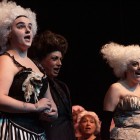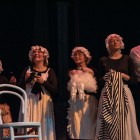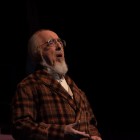Cendrillon 2018Fife Opera
Read more about the opera Cendrillon
Seasonal magic in Kirkcaldy
For 2018, Fife Opera's choice fell on one of the less familiar works, even if the actual plot and title were well calculated to attract an audience to Kirkcaldy. This was, after all, the final run-up to the panto season, in which the Cinderella tale is a regular fixture. Massenet's version, Cendrillon, has scarcely been performed here and must have been an unknown quantity for most of the potential audience.
Production
This Fife production included two casts singing in alternation, featuring both local and international talents. With the Fife Opera chorus, junior chorus and orchestra, under the leadership of Francesco Scattolin, the conductor was Alistair Digges. At the last of four performances, the company delivered an enchanting rendering of the opera, that delighted an audience liberally scattered with young people. Many were probably encountering opera for the first time.
Douglas Nairne's production was clearly laid out in elegant designs, with sets by John Urquhart that were given atmospheric lighting by Mike Pendlowski. These were particularly successful in Act 4, with a section of woodland to the right and Pandolfe's kitchen to the left. This act showed Massenet absorbing influences from two very recent operas, the final scene of Falstaff and the night-time forest scene of Hansel and Gretel. The Fairy supervising the dream sequence was reminiscent first of Nannetta's fairy song in the Verdi, then of Humperdinck's Sandman. Laura Curran delivered this beautiful music with a superb sweetness of tone. Earlier, she had sailed through her fiendish coloratura challenges with ease.
The title-role is not a particularly high part for soprano, and with the Prince composed for mezzo, there were opportunities for the two voices to blend beautifully. Myrna Tennant made a charming heroine and her duets with Jane Monari's Prince provided a foretaste of what Strauss would later achieve in Der Rosenkavalier. Jane Monari, having studied at the Juilliard in New York as well as Glasgow Conservatoire, is now working with the Scottish Opera Chorus (for Edgar) and singing the short role of the Page in the main autumn tour of Rigoletto. It was good to hear her talents in an extended role.
Other parts were generally well-served. The two sisters, played by Rebecca Anderson and Amaya López-Carromero, were particularly good, keeping the traditional over-projection of these characters to a minimum, which increases the comedy. Indeed it is a positive feature of Massenet's treatment that the normally grotesque step-mother and her offspring are three-dimensional characters.
Cendrillon's performance history
This very welcome staging really did Massenet's charming work full justice, and made it very difficult to understand its neglect in the past. Cendrillon was ignored by the major British professional companies until Welsh National Opera staged it in 1993. It appeared at Covent Garden in 2011, and Glyndebourne launched it on their autumn tour of 2018, with further performances to follow at the main Festival in 2019.
It received its Scottish premiere as recently as 2006 when it was staged in Glasgow by the RSAMD (see our review here). As students, Alistair Digges worked on that production, when Douglas Nairne sang a small part, as the Master of Ceremonies. The opera seems to have left them with positive memories, and it is not hard to see why. Perhaps this work may now be seen more often. Anyhow, the delighted reception by the Fife audience should encourage others to give it a look.
Fife Opera
Fife Opera is now the most prominent of the surviving amateur opera companies in Scotland, with a good-sized and well-drilled chorus and a thriving junior branch of children, acting, singing and dancing with relish. To attend one of theiir annual productions is always a thoroughly enjoyable experience. They operate in a part of the country that lacks a theatre that can be used by Scottish Opera's full-size productions, so it is unavoidable that they should perform many works that are in the standard repertoire. Their recent stagings range from Mozart (Magic Flute) to Tchaikovsky (Eugene Onegin). Their French repertoire has included both Carmen and Faust. However Fife Opera also produces relative novelties - Pagliacci was paired not with Cavalleria but with Suor Angelica. In recent years the really adventurous efforts have included Handel (Julius Caesar), Nicolai (Merry Wives of Windsor), Lehár (Land of Smiles) and Delibes (Lakmé).
This matinee on Saturday, which makes it particularly easy for audiences to travel to Kirkcaldy from the Scottish cities, has become a regular fixture of the company's performance routine. The Adam Smith Theatre is just across the road from the railway station and the added attraction of the recently-restored art gallery and museum. The bus station is also very close.
Performance Cast
- Pandolfe Lucette's father
-
Ivor Klayman (Nov 7, 9)
Jonathan Sedgwick (Nov 8, 10)
- Madame de la Haltière Pandolfe's second wife
-
Elaine Young (Nov 7, 10)
Barbara Scott (Nov 8, 10)
- Noémie Madame's elder daughter
-
Louise Thomson (Nov 7, 9)
Rebecca Anderson (Nov 8, 10)
- Dorothée Madame's second daughter
-
Katie Forrest (Nov 7, 9)
Amaya López-Carromero (Nov 8, 10)
- Lucette known as 'Cendrillon'
-
Susanna Davis (Nov 7, 9)
Myrna Tennant (Nov 8, 10)
- La Fée Fairy Godmother
-
Jasmine Munns (Nov 7, 9)
Laura Curran (Nov 8, 10)
- Prince Charmant
-
Grace Wain (Nov 7, 9)
Jane Monari (Nov 8, 10)
- Le Roi King
-
Tom Kelman (Nov 7, 9)
Douglas Nicholson (Nov 8, 10)
- Doyen du Faculté Dean
- Surintendent des plaisirs Master of Ceremonies
- Premier Ministre Prime Minister
- First Spirit
- Second Spirit
- Heraut Herald



















